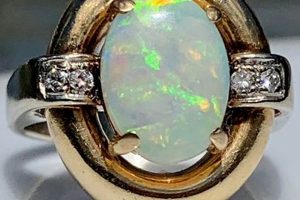Identifying marks on antique jewelry or precious metal objects indicate the item’s gold content, manufacturer, and often, the year of production. These stamps, usually small and requiring magnification to read, serve as a guarantee of the metal’s purity and origin. For example, a mark indicating “18K” signifies that the piece is composed of 75% pure gold, mixed with other alloys to enhance durability and color.
The presence of such markers is crucial in assessing the value and authenticity of older gold items. They provide a traceable history, linking the piece to specific periods, makers, and regulatory standards. These markings also offer protection against fraud, allowing buyers and collectors to verify the metal’s composition and construction techniques utilized at the time of manufacture. They serve as a valuable record of the past, reflecting evolving craftsmanship and trade practices.
Therefore, a closer examination of these indicators is necessary to understand the composition, provenance, and potential worth of antique gold items. The study of these markers unveils a rich tapestry of historical and metallurgical information.
Guidance on Interpreting Historic Gold Purity Marks
The following guidance assists in deciphering the marks found on antique gold objects, enabling a more informed assessment of their composition, age, and potential value.
Tip 1: Magnification is Essential. A jeweler’s loupe or magnifying glass is required to clearly view the small, often intricate, marks. This is the first step toward determining the piece’s hallmarks.
Tip 2: Identify the Karat Mark. Look for numerical indicators followed by “K” or “kt.” Common examples include 10K, 14K, 18K, or 22K, signifying the gold content out of 24 parts. Lower numbers indicate a lower gold percentage.
Tip 3: Research Maker’s Marks. Many manufacturers have unique symbols or initials. Databases and reference guides exist to identify these makers and their period of operation. Cross-referencing the karat mark with the maker’s mark can help verify authenticity.
Tip 4: Consider the Era’s Standards. Gold purity standards varied by region and time. Research the typical marks used during the presumed period of the item to ensure consistency.
Tip 5: Examine for Date Letters. Some assay offices, particularly in the United Kingdom, used date letters within their marks. Matching the letter style to known date charts provides a relatively precise dating method.
Tip 6: Watch for Fakes and Alterations. Be cautious of items with poorly struck marks, unusual placement, or marks that appear inconsistent with the item’s style and period. Counterfeit pieces exist, so due diligence is vital.
Tip 7: Consult an Expert. If uncertainty remains, seek an appraisal from a qualified gemologist or antique jewelry expert. They possess the knowledge and tools to conduct a thorough examination.
These guidelines provide the foundation for understanding the markings on vintage gold items, facilitating a more accurate assessment of their historical significance and intrinsic worth.
The subsequent sections explore common examples and regional variations in greater detail.
1. Karat Designation
The karat designation serves as a fundamental component in the analysis of vintage gold hallmarks. It provides direct insight into the gold content within an object, impacting both its inherent value and historical context.
- Purity Quantification
The karat number, followed by “K” or “kt,” indicates the proportion of pure gold in the alloy, measured out of 24 parts. For instance, 18K signifies 18/24 parts pure gold, approximately 75%. This quantification is crucial for determining the item’s raw material worth. Lower karat designations, such as 9K or 10K, indicate a greater percentage of alloy metals, affecting the item’s market value and durability.
- Standard Variations Over Time
Historical periods exhibited variations in karat standards across different regions. Examining marks from the Victorian era versus the Art Deco period may reveal differing purity expectations and legal requirements. Understanding these variations is essential for accurately dating and assessing the value of older pieces. For example, some European regions favored higher karat gold than the United States during certain periods.
- Impact on Color and Durability
The karat designation influences the color and durability of the gold. Higher karat items, being purer, display a richer yellow hue but are also softer and more prone to scratching. Lower karat gold, alloyed with other metals, offers increased strength and resistance to wear, often manifesting in whiter or rosier tones. This characteristic assists in identifying both the composition and intended use of a piece.
- Relationship to Hallmarking Laws
The presence and accuracy of the karat designation are directly linked to hallmarking laws and regulations. In many countries, legally recognized assay offices verify and stamp items to guarantee the stated gold content. The existence of a legible and verifiable karat mark, coupled with other hallmarks, strengthens the authenticity and provenance of the vintage gold item. The absence of such marks, or inconsistencies within them, may raise concerns about authenticity.
In essence, karat designation acts as a foundational element within the broader framework of vintage gold hallmarks. It allows for the objective assessment of material value, historical context, and compliance with regulatory standards, providing essential information for collectors, historians, and appraisers.
2. Maker's Identification
The maker’s identification represents a critical component within vintage gold hallmarks, offering valuable insights into the origins, craftsmanship, and historical context of a piece. These identifying marks connect the object to a specific artisan, workshop, or manufacturing entity, facilitating provenance research and authentication efforts.
- Decoding Initials and Logos
Maker’s marks frequently manifest as initials, stylized logos, or distinct symbols stamped onto the gold item. Deciphering these marks requires specialized knowledge, often involving referencing databases, historical records, and maker’s mark directories. For example, the mark “TIFFANY & CO.” on a gold item immediately links it to the renowned American jeweler. Correctly identifying these initials allows for further research into the maker’s history, production periods, and design styles.
- Establishing Provenance and Authenticity
A recognized maker’s mark serves as strong evidence of authenticity, verifying that the piece originated from the claimed source. By cross-referencing the maker’s mark with other hallmarks, such as the karat designation and assay office symbol, a more complete picture of the item’s history emerges. The presence of a known maker’s mark increases the likelihood of legitimate origin, especially when combined with stylistic consistency with the maker’s established aesthetic.
- Dating and Geographic Localization
Specific maker’s marks can be associated with particular time periods and geographic locations. Companies evolve over time, changing their logos or marks. By identifying the specific iteration of a maker’s mark, the period of manufacture can be estimated. Additionally, some makers operated primarily in certain regions, providing clues about the piece’s origin. For example, specific maker’s marks are strongly associated with the Birmingham jewelry industry of the 19th century.
- Assessing Craftsmanship and Value
The reputation of a particular maker significantly influences the perceived value and desirability of a vintage gold item. Makers known for exceptional craftsmanship, innovative designs, or historical significance command higher prices among collectors and enthusiasts. Identifying the maker allows for assessment of the object’s quality and artistic merit, impacting its overall valuation.
In conclusion, meticulous analysis of maker’s identification in vintage gold hallmarks provides key insights into the origin, authenticity, and value of antique gold items. These marks serve as tangible links to the past, connecting modern observers with the artisans and manufacturers who created these pieces.
3. Assay Office Symbol
The assay office symbol constitutes a critical element within vintage gold hallmarks, serving as an official validation of the precious metal’s purity and authenticity. These symbols, stamped by legally recognized assay offices, provide a guarantee that the gold content of an item meets specific standards and regulations.
- Guarantee of Purity and Fineness
The primary function of the assay office symbol is to verify the declared gold content, confirming that it matches the karat designation. For example, the leopard’s head mark of the London Assay Office, applied since the 14th century, assures that gold items meet the required standards. This mark offers consumers assurance of the metal’s quality and prevents fraudulent misrepresentation.
- Regional Variations and Historical Context
Assay office symbols vary significantly across different countries and historical periods, reflecting distinct legal and regulatory frameworks. The presence of a specific assay mark can help determine the geographic origin and approximate age of a vintage gold item. For instance, the Irish harp mark indicates assaying in Dublin, while the Swiss Helvetia head identifies Swiss origin post-1882. Understanding these regional variations is essential for accurate assessment.
- Legal Compliance and Consumer Protection
The use of assay office symbols is often mandated by law, ensuring that manufacturers adhere to established standards of gold purity. Items lacking appropriate assay marks may be viewed with suspicion, potentially indicating non-compliance with regulations or even fraudulent intent. The presence of recognizable assay marks provides legal validation and consumer protection, increasing the value and credibility of the vintage gold item.
- Tracing and Authentication Aid
Assay office symbols can be used in conjunction with maker’s marks and date letters to trace the provenance of vintage gold items. By cross-referencing these hallmarks, researchers and collectors can piece together the history of a piece, identifying its origin, manufacturer, and year of production. The combination of assay marks with other identifying features strengthens the authentication process, providing a more complete picture of the item’s history.
In summary, the assay office symbol represents a crucial safeguard within the realm of vintage gold hallmarks, providing essential assurance of purity, legal compliance, and historical context. This symbol significantly contributes to the assessment, authentication, and valuation of antique gold items.
4. Date Lettering
Date lettering, a prominent feature within the system of marks applied to precious metals, provides a precise method for determining the year of manufacture for vintage gold items. Its presence and interpretation are invaluable in establishing provenance and authenticating these objects.
- Sequential Marking Systems
Date letters typically operate within cyclical alphabetic sequences. Each letter represents a specific year within the cycle. The style of the letter (font, case, and surrounding shield) changes with each cycle, allowing for differentiation between periods. For instance, the London Assay Office utilizes a system where each cycle of letters resets every 25 years, using distinct letter fonts and shields for each new cycle. Understanding these sequential systems is essential for accurate dating.
- Geographic and Regulatory Application
The implementation of date lettering is not universal; it is primarily associated with assay offices in the United Kingdom and, to a lesser extent, other Commonwealth countries. These marks were mandated by law to ensure traceability and accountability within the precious metals trade. The absence of date letters does not necessarily indicate a lack of authenticity, but its presence can significantly strengthen the evidence of provenance when dealing with British or Commonwealth hallmarks.
- Deciphering Style and Context
Accurate interpretation of date letters requires careful attention to stylistic details. The specific font, case (upper or lower), and the surrounding shield or cartouche provide crucial clues to the cycle and therefore the year. Reference charts and published guides are essential for comparing these stylistic elements with known date ranges. Misinterpretation can lead to inaccurate dating and potentially inflate or deflate the perceived value of the item.
- Integration with Other Hallmarks
Date letters do not function in isolation; they must be considered in conjunction with other hallmarks, such as the maker’s mark and the assay office symbol. These marks, when aligned chronologically, provide a cohesive narrative of the item’s manufacture and history. Discrepancies between the date letter and other hallmarks can raise red flags, suggesting potential alterations or inconsistencies that warrant further investigation.
The correlation between date lettering and other marks provides a nuanced framework for assessing vintage gold hallmarks. Diligent study and expertise are essential to the correct use of this knowledge in the authentication process.
5. Regional Variations
Regional variations in marking practices significantly influence the interpretation of historic gold hallmarks. The differing legal standards, assaying procedures, and stylistic conventions across various geographic locations necessitate a contextualized approach to hallmark analysis, impacting the assessment of authenticity, age, and value.
- Differing Purity Standards
Gold purity standards have historically varied by region. While some countries favored higher karat gold for jewelry, others permitted or even encouraged lower karat alloys. For example, Continental Europe often utilized 18K gold extensively, whereas the United States saw greater use of 14K and 10K gold. These variations manifest directly in the karat designations found on vintage pieces, requiring knowledge of regional preferences to accurately assess the item’s composition and adherence to local standards.
- Unique Assay Office Marks
Assay offices, responsible for verifying gold purity and applying official hallmarks, operated with distinct symbols and procedures in different regions. The London Assay Office, for instance, employed the leopard’s head mark, while the Dublin Assay Office used the Hibernia mark. Recognizing these geographically specific marks is essential for determining where a piece was assayed, providing valuable information about its origin and potential regulatory compliance. Variations in the style and implementation of these marks further aid in dating and authentication.
- Stylistic Conventions in Maker’s Marks
The style and format of maker’s marks often reflect regional design trends and manufacturing practices. Jewelers in Paris, for example, frequently incorporated intricate initials or logos into their hallmarks, while those in Birmingham tended towards simpler, more utilitarian marks. Understanding these stylistic conventions allows for identification of potential regional origins and assists in differentiating authentic marks from potential forgeries. Cross-referencing maker’s marks with known regional styles strengthens authentication efforts.
- Variations in Date Lettering Systems
The use of date lettering, a system of cyclical alphabetic symbols indicating the year of assay, was primarily employed in the United Kingdom and some Commonwealth countries. Other regions did not utilize this system, relying instead on different methods of indicating date or origin. The presence or absence of date letters, and the specific style of those letters when present, provides critical information about a piece’s geographic origin and potential period of manufacture. Familiarity with the various date lettering systems is essential for accurate interpretation of hallmarks.
The accurate interpretation of vintage gold hallmarks requires a thorough understanding of regional variations in purity standards, assay office marks, maker’s mark styles, and date lettering systems. These variations emphasize the need for contextualized analysis, considering the geographic origin and historical period of the item to effectively assess its authenticity, age, and value.
Frequently Asked Questions
The following addresses common inquiries regarding the assessment and interpretation of these indicators found on antique gold items.
Question 1: What tools are necessary for examining gold hallmarks?
A jeweler’s loupe with at least 10x magnification is essential for detailed viewing of the small markings. Proper lighting is also crucial to ensure clear visibility. Reference guides to maker’s marks and assay office symbols are also valuable resources.
Question 2: How does one distinguish between a genuine hallmark and a fraudulent one?
Genuine marks are typically sharply struck and consistent with the style and standards of the period. Fraudulent marks often appear blurry, irregularly placed, or inconsistent with known hallmark characteristics. Consultation with a qualified appraiser is recommended for uncertain cases.
Question 3: What information can be derived from a vintage gold hallmark?
The marks reveal the gold content (karat), manufacturer or maker, assay office of origin, and often the year of manufacture. This information contributes to determining authenticity, provenance, and value.
Question 4: Why are some vintage gold items unmarked?
Items may be unmarked due to wear, alteration, or because they predate mandatory hallmarking regulations. The absence of a mark does not automatically indicate inauthenticity, but it necessitates further investigation to determine the item’s composition and origin.
Question 5: Where can one find reliable resources for identifying vintage gold hallmarks?
Reputable sources include books on antique jewelry, online databases of maker’s marks, and professional organizations for gemologists and appraisers. Consultation with established experts is highly recommended for complex cases.
Question 6: How do regional differences affect the interpretation of vintage gold hallmarks?
Different regions adhered to varied purity standards, employed unique assay office symbols, and exhibited distinct maker’s mark styles. Understanding these regional variations is crucial for accurate assessment of a piece’s origin and compliance with applicable standards.
Thorough understanding of these indicators is key to discerning the history and intrinsic worth of vintage gold.
The subsequent discussion explores the role of professional appraisal in evaluating historical gold items.
Conclusion
The examination of “vintage gold hallmarks” reveals a complex system of indicators, essential for authenticating and valuing antique gold items. Karat designations, maker’s identifications, assay office symbols, and date letters, each contribute critical information about a piece’s composition, origin, and period of manufacture. Regional variations further complicate the analysis, demanding specialized knowledge of differing standards and practices.
A rigorous approach to understanding these markings remains paramount. Authentication and valuation require careful observation, detailed research, and, when necessary, professional consultation. The study of “vintage gold hallmarks” offers a pathway into the rich history of goldsmithing and trade. Continued research and documentation are critical to preserving the knowledge embedded within these marks for future generations.







